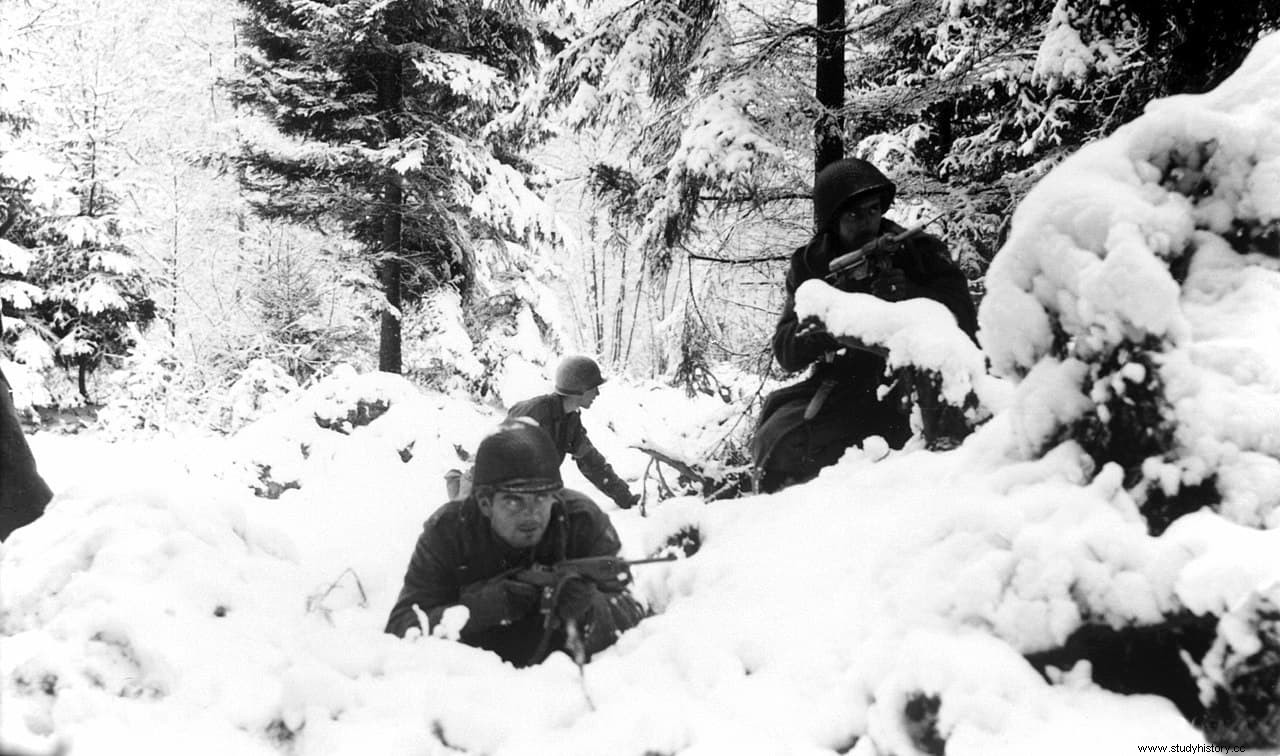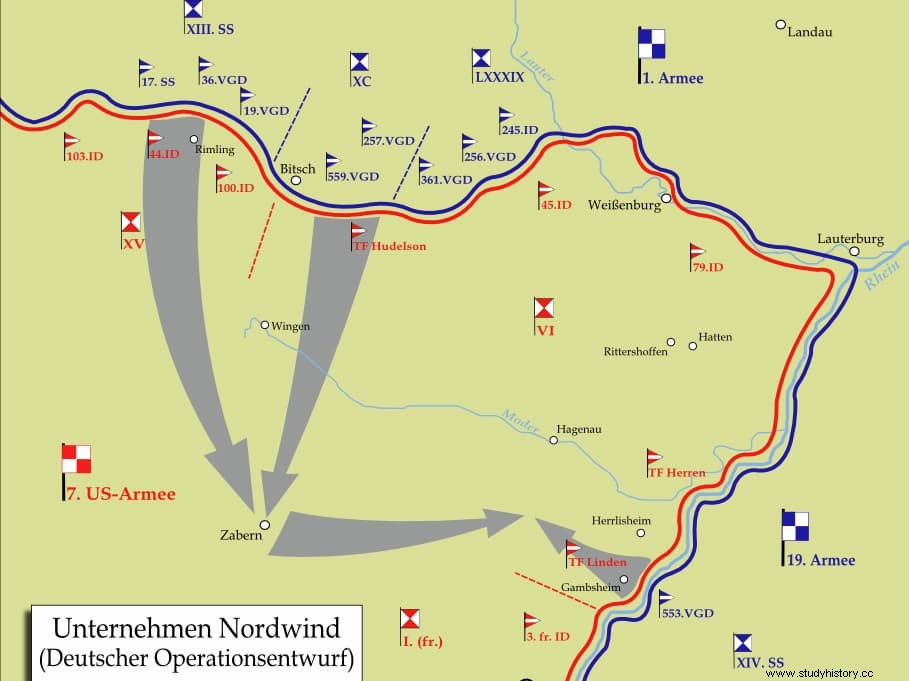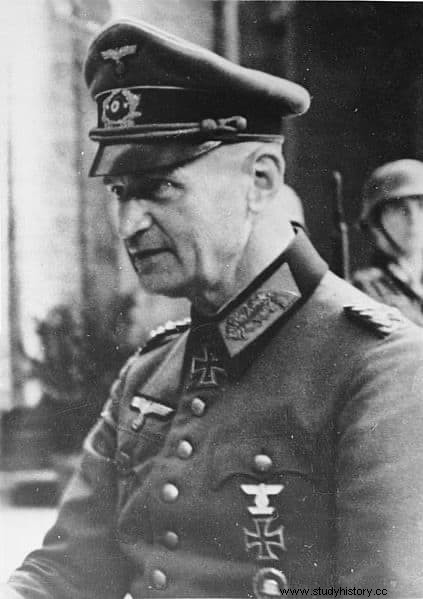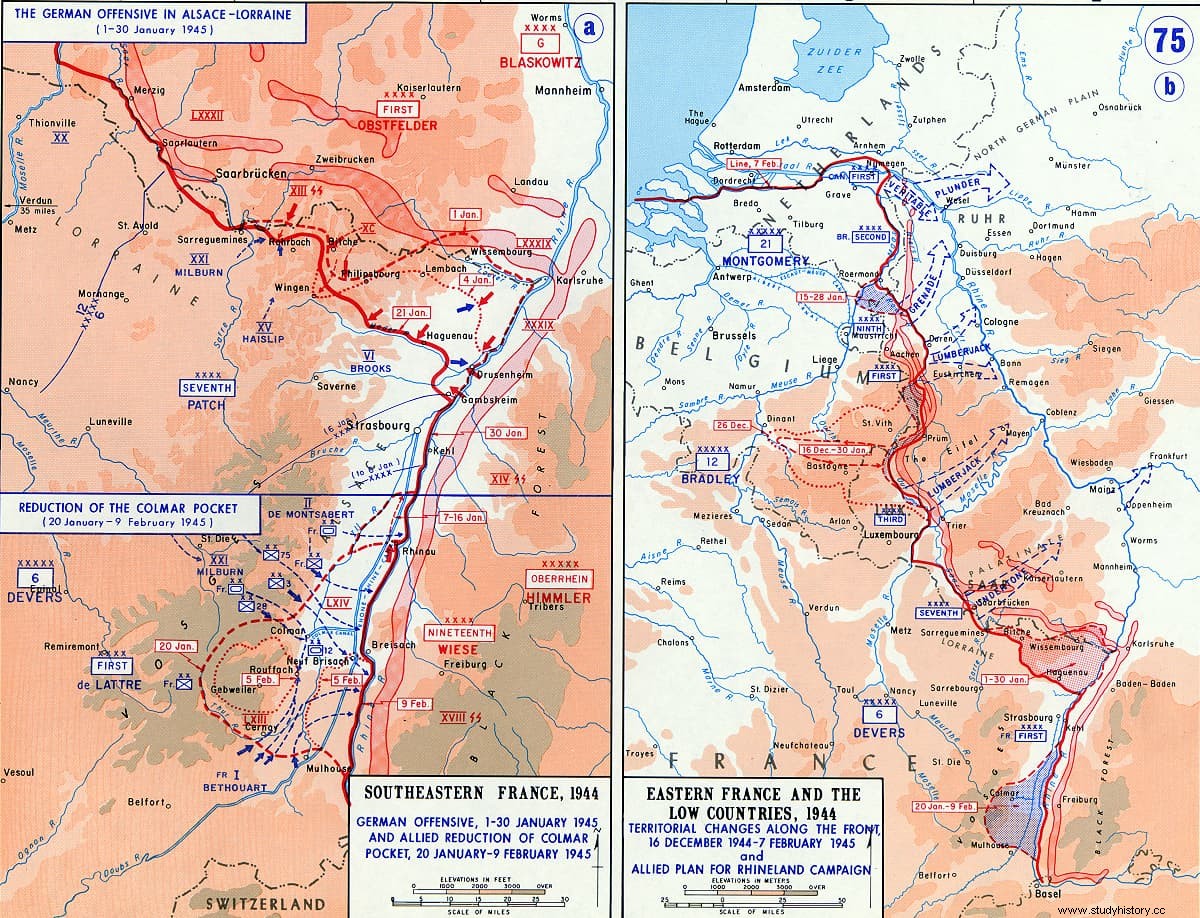In the winter of 1944, all the belligerent countries in the Second World War were clear that Germany had lost and the end of the conflict was only a matter of time, which Hitler was willing to delay. The Nazi leader, in effect, still tried to make a final and desperate move:the Unternehmen Nordwind (Operation North Wind, better known as Operation Nordwind), which was the last major German offensive against Allied forces on the European Western Front. And it failed.
Nordwind did not appear suddenly but as a support or complement to another offensive that began on December 16, 1944, that of the Ardennes (Ardennenoffensive or Rundstedt-Offensive ), which in turn was subdivided into other minor related operations:Bodenplatte, Greif and Währung. Its objective was to cross the Belgian forests, take Antwerp and split the Allied line, pocketing the four armies - British and American - that formed it to force a peace negotiation that would allow the Wehrmacht to focus on the Eastern Front.

Difficult weather conditions, which prevented aerial reconnaissance, and an overconfidence of the Allies caused them to be taken by surprise by the Germans. However, the stiff resistance at Bastogne, the improving weather and the rapid flow of reinforcements turned the situation around, so that by January 25, 1945, Hitler's desperate attempt to stop the enemy advance ended in retreat. towards the Siegfried Line with heavy losses, although also suffered by the Americans. That was the context in which Operation Nordwind was set up.
Fifteen days after starting their attack on the Ardennes, the Teutonic troops had stalled. To the harshness of the winter, another important adversity had to be added, such as the lack of fuel for the armored vehicles, which is why it was considered necessary to open another front. In contrast to the Belgian and Luxembourg forests, the area of the Vosges valley and the Alsace plain was chosen, where the US Sixth Army Group under General Jacob Devers and the US Seventh Army, led by Alexander Patch, operated. , plus the First French Army of Jean de Lattre de Tassigny. They were stationed there by Eisenhower to divert enemy troops from the Ardennes and facilitate a counterattack.

But precisely for this reason they constituted the weakest link, and against them, Marshal von Rundstedt mobilized General Johannes Albrecht Blaskowitz's Army Group G (where Hans von Obstfelder's First Army was located), the newly formed Army Group Rhine commanded by Heinrich Himmler and Sigfried Rasp's Nineteenth Army. It is not clear how many men they added to each other, calculating the Allies at something less than a quarter of a million for an unknown figure in the German case.
The objective set by Hitler was to destroy the adversary and take Strasbourg, which would allow the Unternehmen Zahnarzt to be unleashed. (Operation Dentist):the plan to end Patton's Third Army -which on December 26 managed to break the Bastogne siege- after a pincer movement. The offensive began on December 31, 1944, acting on a narrow front of one hundred and ten kilometers against the US Seventh Army. That unexpected blow caused a threat of retreat that triggered bitter discussions between the Allied commanders; transferred to the high spheres, with Eisenhower and De Gaulle facing each other, only the mediation of Churchill restored calm.

And it is that the surprise was total, something that the Germans had considered essential to the point that there were no previous bombings. Later, throughout the day, a thousand planes were sent to prevent the action of rival aviation. It was the aforementioned Operation Bodenplatte, which although it managed to cause heavy casualties to the Allies, in general terms it not only did not succeed but also meant the loss of hundreds of units and pilots in a very short time (some hit by German anti-aircraft, taking them for enemies for not having been informed of their presence) and aggravate the progressive weakening of the Luftwaffe.
The three corps that formed the German First Army staged the first attacks and occupied Wingen on January 4. However, the difficulties of the terrain and the lack of reinforcements hampered progress and two days later, faced with an American counterattack, they had to withdraw from the city. Attention was then focused on the Upper Rhine plain, where the population was pro-German, something that made it possible to cross the river without problems and establish a bridgehead. Meanwhile, the First Army pushed back the French, who eventually established a line of resistance at Benfeld.
In mid-January, the situation stagnated, with successive coups by one side and the other. Entering the second half of the month, the Germans failed in their first attempt to reach Strasbourg, the Gauls repulsed an attack at Kilstedt, and the Americans received word that reinforcements were being sent:the 101st Parachute Division, liberated from the Ardennes at definitively fail that Teutonic offensive on the 25th. But bad weather delayed their arrival, forcing a retreat south of the Moder River. With the way clear, the Germans used the aforementioned bridgehead to pass more troops and resume their advance, with the city of Zabern on the horizon.

They could not. Along the way they crashed trying to seize Hagenau and Bischweiler, while at other points they began to receive Allied attacks, once they were able to take position. In just three days, from January 22 to 25, the situation turned around and, fearing that the Eastern Front would collapse, Hitler ordered Operation Nordwind to be stopped in order to withdraw two of the three Panzer divisions and use them to contain the Soviets. , already leaving eastern Prussia behind, as General Guderian had warned in vain when the offensive was approved.
Only the so-called Colmar Pocket remained, for three weeks, an anomaly within the whole:some units of the German Nineteenth Army resisted in the city of the same name until February 9. But it was a mirage. Despite its tactical victories, the offensive strategically failed to meet its goal of slowing down the enemy, becoming what historian Anthony Beevor considers the equivalent of the Kaiserlacht. , the last major German attack of the First World War.

The German casualties are estimated at around 23,000, for about 7,000 French and just under 12,000 Americans, aggravated by those suffered in the aforementioned Operation Dentist, which also went wrong:it began on January 1 and ended just three days later, when see their supply lines cut off by heavy Allied artillery and aerial bombardment.
Alsace became French again and Eisenhower was able to start Operation Undertone in March:clear the Palatinate of enemies in order to accumulate all forces on the banks of the Rhine and cross it.
